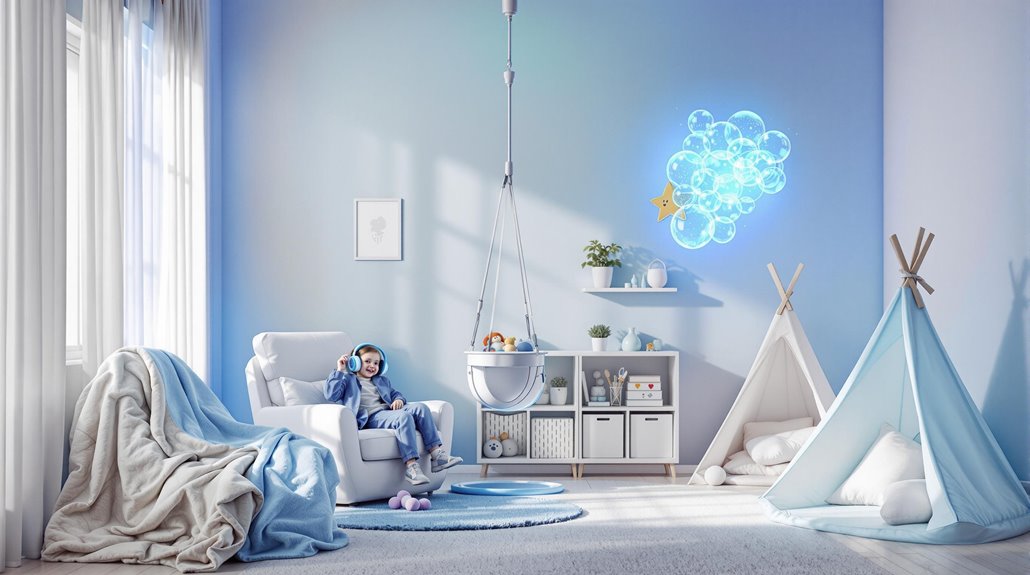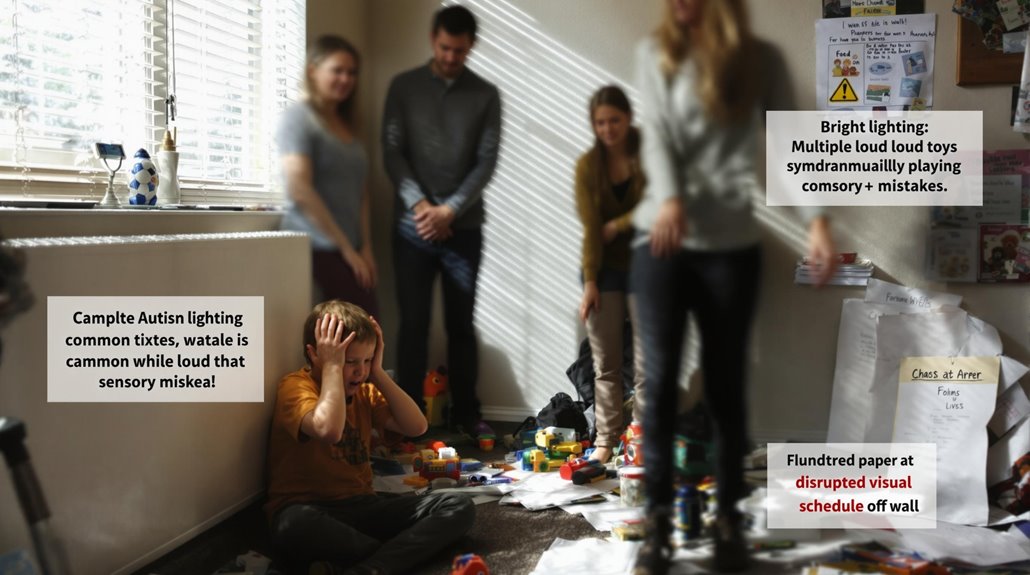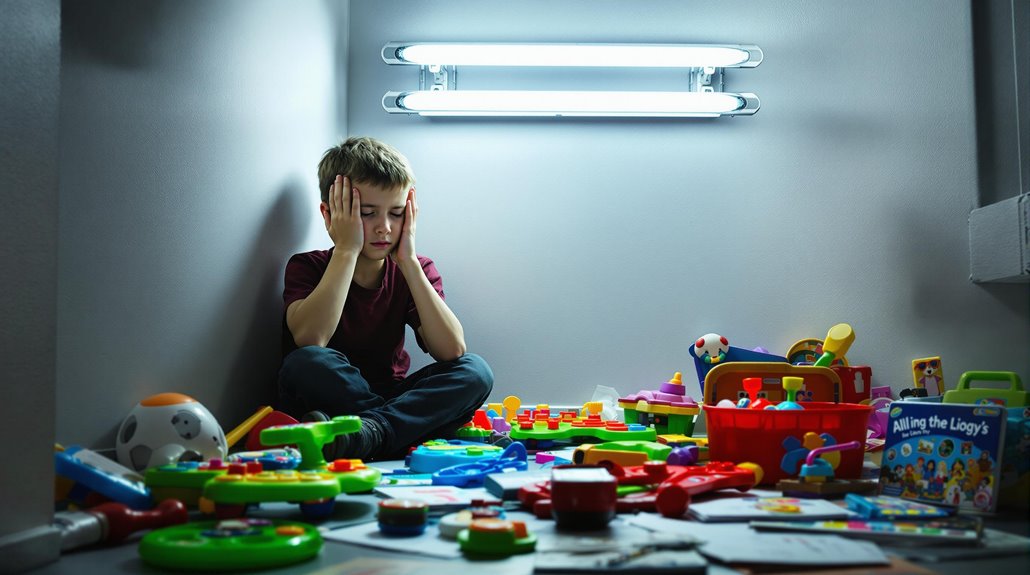Key Takeaways
- Create a designated sensory-safe space with weighted blankets, dimmable lights, and calming colors where children can retreat when overwhelmed.
- Practice deep breathing exercises using visual aids and counting methods to help regulate emotions during stressful situations.
- Use visual schedules and routine cards to create predictable environments and reduce anxiety during daily transitions.
- Incorporate regular physical activities like yoga, nature walks, or structured movement games to release energy and reduce stress.
- Provide fidget toys and sensory tools that offer tactile stimulation and help maintain focus during challenging moments.
Deep Breathing Exercises for Emotional Balance
Mastering deep breathing exercises provides children with autism a powerful tool for regulating their emotions and managing stress. Through consistent practice, these techniques help children develop greater awareness of their emotional states while creating a sense of calm.
Simple breathing exercises can be taught using visual aids or counting methods that make the process engaging and easy to follow. When children learn to take slow, deliberate breaths during moments of anxiety or overwhelm, they activate their body’s natural relaxation response.
This form of emotional regulation becomes particularly valuable during changes or challenging situations, offering an accessible strategy they can use independently whenever needed. Similar to chronic pain management techniques used in physical therapy, these breathing exercises can provide immediate relief and long-term benefits when practiced regularly.
Visual Aids and Support Systems
While deep breathing exercises provide internal tools for emotional regulation, visual aids offer powerful external support for children with autism to navigate daily life.
Visual schedules break down daily routines into clear, sequential steps, reducing anxiety about changes and unexpected alterations.
Breaking routines into visual steps creates a clear pathway through the day, helping children navigate change with greater confidence.
Communication boards enable children to express needs and emotions effectively when verbal communication proves challenging.
These visual supports create predictability and structure, essential elements for maintaining calm in various environments.
Whether through picture cards, charts, or digital applications, visual aids help children understand expectations, process information, and develop greater independence in managing their emotional responses.
Similar to how care plan assessment helps families create customized solutions, visual aids can be tailored to each child’s unique needs and preferences.
Creating a Sensory-Safe Space
Creating a sensory-safe space represents a critical component in supporting children with autism who may experience sensory sensitivities or become overwhelmed by environmental stimuli.
This designated area should incorporate sensory friendly furniture such as bean bags, weighted blankets, and soft cushions that provide comfort and security.
Calming color schemes featuring neutral or muted tones help reduce visual overstimulation, while maintaining a peaceful atmosphere.
The space should also include elements that address various sensory needs, such as dimmable lighting, noise-canceling features, and textured materials.
This thoughtfully designed environment enables children to self-regulate and find refuge when feeling overwhelmed.
Similar to how non-skilled care services provide structured routines and emotional support for individuals with memory challenges, a sensory-safe space offers essential comfort and stability for children with autism.
Active Movement and Exercise Programs
Beyond the calming benefits of a sensory-safe space, physical activity offers powerful therapeutic advantages for children with autism. Active play and movement games provide essential outlets for energy while developing vital motor skills and emotional regulation.
Structured exercise benefits include improved focus, reduced anxiety, and enhanced social interaction through team activities. Outdoor adventures create opportunities for sensory exploration while building confidence through physical challenges.
Fun workouts can be tailored to each child’s abilities and interests, from swimming to obstacle courses. When implemented consistently, these movement-based programs help children develop body awareness, coordination, and social connections while managing stress effectively. Skilled nursing staff can assist in developing personalized exercise routines that complement other therapeutic interventions at home or school.
The Power of Music and Sound Therapy
Music serves as a powerful therapeutic tool for children with autism, offering unique pathways to emotional regulation and sensory integration. Research indicates that carefully selected sound frequencies can stimulate calming responses in the nervous system, reducing anxiety and promoting focus.
Strategic music playlist creation allows parents and caregivers to customize audio experiences that resonate with their child’s specific needs. Gentle classical compositions, nature sounds, or familiar melodies can create a soothing environment during potentially stressful situations.
Sound frequency benefits extend beyond immediate calming effects, potentially supporting improved communication skills and emotional expression over time. Memory care specialists can help develop personalized music therapy programs that complement existing cognitive support services.
Mindfulness and Meditation Techniques
While traditional meditation practices may seem challenging for children with autism, modified mindfulness techniques can provide essential tools for emotional regulation and stress management.
Simple mindfulness practices, adapted to each child’s abilities, can include focused breathing exercises, guided body awareness, and gentle movement activities.
Mindfulness adapts to meet children where they are, offering accessible paths through breath work, body scanning, and mindful movement exercises.
These meditation exercises can be introduced gradually, starting with brief sessions that incorporate visual aids or sensory elements.
Children can learn to recognize physical sensations, emotions, and thoughts without becoming overwhelmed.
Regular practice helps develop coping strategies for managing anxiety and stress, while building awareness of their immediate environment and internal experiences.
Working with Focus Family Care professionals can provide additional guidance on implementing personalized mindfulness strategies that align with each child’s unique needs and capabilities.
Building Structured Daily Routines
Establishing consistent daily routines provides children with autism a vital framework for traversing their world with greater confidence and reduced anxiety. Visual schedules and daily checklists serve as essential tools, helping children understand what to expect throughout their day.
These structured routines should encompass all daily activities, from morning preparations to bedtime rituals. Breaking down complex tasks into manageable steps makes activities more approachable and less overwhelming.
When children can anticipate their schedule, they experience fewer behavioral challenges and demonstrate improved emotional regulation. Parents and caregivers can gradually introduce new activities while maintaining the comfort of familiar patterns. Skilled nursing care can provide additional support in maintaining these routines while addressing any medical needs that arise.
Social Stories and Peer Interactions
Social stories serve as powerful tools for children with autism to navigate complex social situations and develop meaningful peer relationships. Through carefully structured narratives and peer modeling, children learn essential social skills in a supportive environment.
- Illustrates appropriate responses to common social scenarios
- Creates predictable frameworks for understanding peer interactions
- Reduces anxiety by preparing children for new social experiences
- Incorporates visual supports to enhance comprehension
- Facilitates natural opportunities for practicing social skills
These evidence-based strategies help children build confidence in social settings while providing clear examples of successful interactions.
When combined with direct peer modeling, social stories create a foundation for developing lasting friendships and positive social experiences.
Private duty nursing services can provide specialized support for children with autism who need additional assistance during social interactions.
Video Learning and Behavior Mapping
Visual learning tools like video modeling and behavior mapping provide powerful strategies for children with autism to understand and internalize appropriate behavioral responses.
These evidence-based techniques allow children to observe and learn appropriate social interactions, emotional regulation, and daily living skills through structured visual demonstrations.
Video modeling presents real-life scenarios that children can watch repeatedly, helping them process information at their own pace.
Behavior mapping creates clear visual representations of cause-and-effect relationships, breaking down complex social situations into manageable steps.
Together, these approaches offer concrete examples that support children in developing new skills while reducing anxiety about unfamiliar situations.
Similar to post-hospital recovery therapy, these visual tools help children gradually build confidence and independence through structured learning approaches.
School-Based Support Strategies
While traversing the school environment can present unique challenges for students with autism, implementing thorough support strategies within educational settings proves essential for their academic and social success.
Through school collaboration and individualized support, educators can create an environment that promotes learning and emotional regulation.
Collaborative educational approaches paired with personalized student support create optimal conditions for both academic growth and emotional development.
Similar to how mobility support specialists assist Parkinson’s patients with movement challenges, schools can implement targeted assistance for students with autism.
- Designated quiet spaces within classrooms for sensory breaks
- Visual schedules and routine cards at students’ desks
- Close partnership between teachers and behavior specialists
- Strategic seating arrangements to minimize environmental triggers
- Regular communication between school staff and families
These evidence-based approaches help students navigate their school day effectively while maintaining emotional equilibrium and fostering positive learning experiences.
Managing Changes and Transitions
Because changes can trigger anxiety and emotional dysregulation in children with autism, implementing effective management strategies becomes essential for their daily functioning.
Shift preparation helps children develop emotional resilience by providing predictable routines and clear expectations.
Visual schedules, social stories, and timer-based warnings serve as valuable tools to guide children through daily shifts.
Incorporating familiar objects or comfort items during changes can provide security.
Breaking shifts into smaller, manageable steps reduces overwhelm.
Additionally, practicing shifts during calm periods allows children to build confidence and coping skills, making future changes less challenging.
Calming Scents and Aromatherapy Benefits
Through carefully selected aromatic compounds, aromatherapy offers significant calming benefits for children with autism who experience sensory sensitivities or anxiety.
Research indicates that specific calming oils can support sensory integration and promote emotional regulation through gentle olfactory stimulation.
- Lavender essential oil helps reduce anxiety and promotes better sleep patterns
- Vanilla scents create a sense of comfort and emotional stability
- Chamomile supports relaxation and stress reduction
- Sweet orange oil enhances mood and reduces nervous tension
- Sandalwood helps ground emotions and provides a calming presence
Individual scent preferences vary, making it essential to observe each child’s emotional responses and adjust aromatherapy approaches accordingly.
Muscle Relaxation and Gentle Touch
Progressive muscle relaxation and gentle touch techniques offer powerful tools for children with autism to develop body awareness and reduce physical tension. Through systematic tensing and releasing of muscle groups, children learn to identify and manage physical stress signals in their bodies.
Gentle touch activities, such as light pressure or therapeutic massage, can help regulate the nervous system and promote a sense of calm. When implemented consistently, these techniques enhance muscle awareness and provide a structured approach to relaxation.
Parents and caregivers can guide children through these exercises during daily routines, creating opportunities for bonding while teaching valuable self-regulation skills.
Sensory Toys and Break Time Activities
Physical calming techniques work well alongside tactile tools and structured breaks. Sensory exploration activities provide essential outlets for children with autism to regulate their emotions and maintain focus throughout the day.
Sensory tools and calming activities create vital pathways for children with autism to process emotions and stay engaged in daily tasks.
- Fidget toy benefits include improved concentration and reduced anxiety during challenging tasks.
- Stress balls and squeeze toys offer immediate tactile feedback for emotional regulation.
- Quiet corners with weighted blankets create safe spaces for decompression.
- Sand and water tables encourage mindful sensory exploration activities.
- Timer-guided breaks help structure sensory experiences and shifts.
These tools and activities, when implemented consistently, help children develop self-regulation skills while providing comfortable opportunities for sensory engagement.
Strategic placement of sensory stations throughout learning environments supports continuous access to calming resources.
Understanding Emotional Triggers and Responses
Identifying emotional triggers in children with autism requires careful observation and systematic documentation of behavioral patterns. Parents and caregivers can develop emotional awareness by tracking specific situations, environments, or stimuli that consistently precede challenging behaviors.
Through careful trigger identification, caregivers can recognize early warning signs such as increased agitation, withdrawal, or physical responses. Common triggers may include loud noises, bright lights, schedule changes, or social demands.
Understanding these patterns enables proactive intervention strategies, helping children develop better coping mechanisms. This knowledge allows caregivers to create supportive environments and implement appropriate calming techniques before emotional responses escalate.
Conclusion
Implementing calming strategies for children with autism transcends basic behavioral management, becoming an absolutely essential cornerstone of their developmental journey. Through the monumental power of these techniques, from the transformative effects of deep breathing to the revolutionary impact of sensory spaces, children can develop an astronomical capacity for self-regulation. When caregivers and professionals unite in deploying these strategies, they create an extraordinarily robust foundation for emotional stability and lifelong success.





